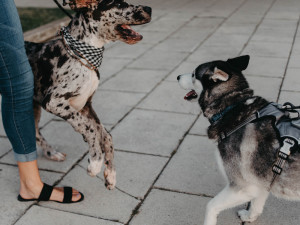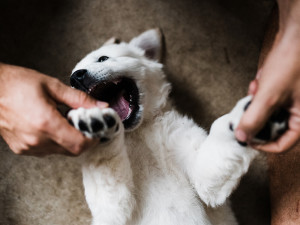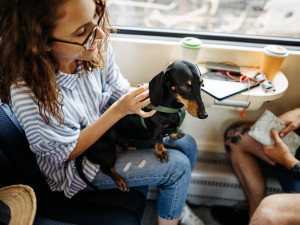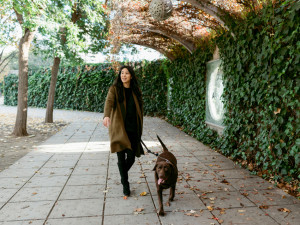Decoding Your Dog’s Growls
When your dog growls, they’re expressing their emotions. A study found that you’ll probably be able to understand what they’re feeling

Share Article
Your dog gets an earful about your day, especially when there are no humans around to hear your list of daily grievances (and they are long!). But have you ever listened to your dog – like, really listened to them when they grumble or growl? Do you swear you can understand their deepest emotions and desires? It turns out, when your dog is growling, they are expressing their emotions – and most likely, you’ll be able to understand what they’re feeling.
Why do dogs growl?
Dogs growl in different contexts – when guarding something of value, when threatened by a stranger and during play. These growls can sound remarkably similar to the novice human ear, but a study in the journal Animal Behavior suggests that the meanings of these growls are very different to dogs.
Types of dog growl
guarding resources (such as food, toys and space)
warning growls when threatened or fearful
play growls
growling in pain
Scientists in Hungary recorded growls by dogs in different situations and analysed the structure of the sounds. The growls recorded during play were very different than the other two types of growls – they were shorter and higher in pitch.
After discovering the variance in sound, they tested the theory. They gave dogs the opportunity to approach a high-quality food item (a cooked meaty bone) when alone in a room. Then, they piped in the recorded sound of either a growl made when a dog was threatened by a stranger or a growl made by a dog guarding a bone. They tested 41 dogs in this way and found that dogs were significantly more likely to back away from the bone when they heard the bone-guarding growl than when they heard the threatened-by-a-stranger growl.
Identifying dog growls
A study published in Royal Society Open Scienceopens in new tab found that humans were able to identify dogs’ growls within the context of the setting. When given the options of three social situations (guarding food from another dog, playing tug with a person and being approached by a stranger), people were able to differentiate what emotion the growling dog was experiencing in that moment. “We found that playful growl bouts are built up from short, quickly repeated growls, while the aggressive ones were more elongated,” explains lead researcher Tamás Faragó. “The food guarding growls differed from the threatening growls in their formant dispersion, a parameter that gives a size impression of the vocalising individual for the listeners.”
People were asked to rate each growl on a sliding scale for each of the following emotions: fear, aggression, despair, happiness and playfulness. Overall, people correctly identified the context of 63 percent of the growls, which is significantly better than the 33 percent rate that chance predicts. The play growls were most readily identified, with 81 percent of them being correctly chosen. The food guarding growls were correctly identified 60 percent of the time, compared with 50 percent of the growls directed at strangers. Most of the errors in identifying these two (potentially aggressive) contexts involved confusion between the two of them, rather than with the playful context.
It may come as no surprise that dog people were better than non-dog people at correctly identifying a growl's meaning. The study also found that women were better at distinguishing between the growls. “This is a common pattern in emotion recognition studies,” says Tamás. “Probably some women are more empathic and sensitive to others’ emotions, and this helps them to better associate the contexts with the emotional content of the growls.”
The researchers’ takeaway from the study was that people can distinguish different types of dog growls, including being able to tell apart growls that are both in potentially aggressive contexts. Previous studies have found that people’s ability to understand canine growls is influenced by the time between growls and the duration of the growls – longer gaps between growls is associated with higher aggression scores. Shorter growls are generally perceived as more positive on emotional scales. In growls recorded in the context of a stranger approaching, the higher the pitch of the growl, the higher the fearfulness score.
Individual people varied in their ability to identify the context of the growls, too. Overall, women were better at it then men. Pet parents also outperformed people who don’t have dogs. Whether or not a person had ever been bitten by a dog had no effect.
Dogs have a huge range of vocalisations and yet much remains to be learned about the differences in meanings of their vocal communication. These studies are one step towards a fuller understanding of the vocal repertoire of dogs and how we interpret their emotions.

Karen B. London, PhD, CAAB, CPDT-KA
Karen B. London, Ph.D., is a Certified Applied Animal Behaviorist and Certified Professional Dog Trainer who specializes in working with dogs with serious behavioral issues, including aggression, and has also trained other animals including cats, birds, snakes, and insects.
Related articles
![]()
All Aboard! How To Take Your Dog On A Train Journey
Heading on a UK break? Here’s how to help your pup (and you) survive that stressful train journey
![Woman walking her dog in a park]()
Dog Walking 101: How Often You Should Walk Your Dog
Your dog may need more exercise than you think, according to three pet experts
![Dog walker walking with her pet on leash on the sidewalk]()
10 Tips You’ll Definitely Want to Follow When You Walk Your Dog
From the safest gear to training recommendations
![Dachshund dog freezing on a rock during a walk]()
Why Does My Dog Turn Into a Statue on Walks?
Suddenly, the pavement has some new installation art: your frozen dog
![Woman and dog sleeping together in bed]()
Where Should Your Dog Sleep At Night-Time?
It’s a personal preference, but here are the pros and cons
![Two hands holding a very young tan and white puppy up in front of a lake landscape]()
How to Socialise a Puppy
Everything you need to know to get your new addition off to a good start








